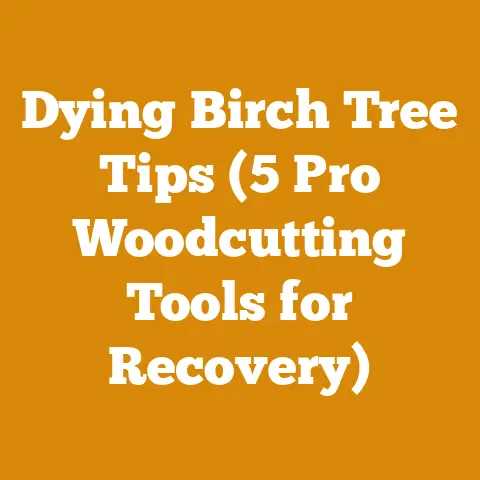Sharpen Wood Chipper Blades Like a Pro (7 Insider Tips)
As someone who has spent countless hours wrestling with wood, from felling towering trees to meticulously stacking firewood, I know firsthand the frustration of dull wood chipper blades.
Wear and tear are inevitable.
The relentless assault of wood, dirt, and debris takes its toll.
A sharp blade slices through wood with ease, turning branches into manageable mulch.
A dull blade, on the other hand, struggles, bogging down the engine, increasing fuel consumption, and producing uneven, stringy chips.
In this article, I’m going to share seven insider tips I’ve learned over the years to sharpen wood chipper blades like a pro.
These aren’t just theoretical concepts; they’re practical techniques honed through trial and error, observation, and a healthy dose of stubborn determination.
Whether you’re a seasoned arborist or a weekend warrior tackling yard waste, these tips will help you keep your wood chipper running smoothly and efficiently.
Sharpen Wood Chipper Blades Like a Pro (7 Insider Tips)
1. Understanding Your Wood Chipper Blades
Before you even think about sharpening, it’s crucial to understand the type of blades your wood chipper uses.
Wood chipper blades aren’t one-size-fits-all.
There are different designs, materials, and bevel angles, each suited for specific types of wood and chipping applications.
Blade Materials:
- High-Speed Steel (HSS): HSS blades are known for their hardness and ability to hold an edge for a relatively long time.
They are suitable for chipping hardwoods and softwoods. - Carbon Steel: Carbon steel blades are less expensive than HSS blades but don’t hold an edge as well.
They are best suited for softer woods and occasional use. - Carbide-Tipped: Carbide-tipped blades are the most durable and expensive option.
They are ideal for chipping abrasive materials like treated wood, palm fronds, and debris-laden branches.
Blade Designs:
- Flat Blades: Flat blades are the most common type and are used in many smaller wood chippers.
They have a single bevel angle and are relatively easy to sharpen. - Curved Blades: Curved blades are designed to slice through wood more efficiently.
They are often found in larger, more powerful wood chippers. - Notched Blades: Notched blades have small notches or teeth along the cutting edge.
These notches help to grab and pull the wood into the chipper.
Bevel Angles:
The bevel angle is the angle of the cutting edge.
The ideal bevel angle depends on the type of wood you’re chipping.
Softer woods require a steeper angle (around 30-35 degrees), while harder woods require a shallower angle (around 20-25 degrees).
Consulting your owner’s manual or contacting the manufacturer can provide specific recommendations for your chipper model.
Personal Story: I remember when I first started using a wood chipper.
I assumed all blades were the same and used the same sharpening technique on every blade.
I quickly learned that this was a mistake.
I ruined a set of carbide-tipped blades by using the wrong grinding wheel.
That experience taught me the importance of understanding the specific characteristics of each blade type.
2. Safety First: Preparing for the Sharpening Process
Sharpening wood chipper blades can be dangerous if you don’t take the necessary precautions.
Before you start, make sure you have the following safety equipment:
- Safety Glasses: Protect your eyes from flying sparks and debris.
- Gloves: Protect your hands from cuts and abrasions.
- Dust Mask: Protect your lungs from inhaling metal dust.
- Ear Protection: Protect your ears from the noise of the grinder.
Machine Preparation:
- Disconnect the Spark Plug: This is the most important step.
Disconnecting the spark plug prevents the engine from accidentally starting while you’re working on the blades. - Secure the Rotor: Prevent the rotor from spinning by engaging the brake or using a locking pin.
- Remove the Blades: Carefully remove the blades from the chipper.
Refer to your owner’s manual for specific instructions.
Typically, this involves loosening bolts or removing retaining clips.
Work Area:
Choose a well-lit and well-ventilated work area.
Make sure you have enough space to move around comfortably and that your work surface is stable and secure.
Data Point: According to the National Safety Council, approximately 15,000 people are injured each year while using lawn and garden equipment, including wood chippers.
Taking proper safety precautions can significantly reduce your risk of injury.
3. Choosing the Right Sharpening Tools
The right tools can make all the difference in the quality and efficiency of your sharpening.
Here are some of the most common tools used for sharpening wood chipper blades:
- Bench Grinder: A bench grinder is a stationary power tool with two abrasive wheels.
It’s ideal for sharpening blades quickly and efficiently.
Look for a bench grinder with adjustable tool rests and a water cooling system to prevent overheating the blades. - Angle Grinder: An angle grinder is a handheld power tool with a rotating abrasive disc.
It’s more versatile than a bench grinder and can be used for sharpening blades in place.
However, it requires more skill and control to avoid damaging the blades. - Sharpening Stone: A sharpening stone (also known as a whetstone) is a traditional tool for sharpening blades.
It’s slower than a power grinder but provides more precise control over the sharpening process. - Diamond File: A diamond file is a hand tool with a diamond-coated surface.
It’s ideal for sharpening carbide-tipped blades, which are too hard for traditional sharpening stones.
Grinding Wheels:
The type of grinding wheel you use is just as important as the grinder itself.
Here are some common types of grinding wheels:
- Aluminum Oxide: Aluminum oxide wheels are general-purpose wheels suitable for sharpening most types of steel blades.
- Silicon Carbide: Silicon carbide wheels are harder than aluminum oxide wheels and are ideal for sharpening carbide-tipped blades.
- CBN (Cubic Boron Nitride): CBN wheels are extremely hard and durable.
They are used for sharpening high-speed steel and other hard materials.
Personal Story: When I first started sharpening blades, I used a cheap bench grinder with a coarse grinding wheel.
I quickly learned that this was a recipe for disaster.
The coarse wheel removed too much material too quickly, and I ended up overheating and damaging the blades.
I upgraded to a bench grinder with a finer wheel and a water cooling system, and the results were dramatically better.
4. The Art of Sharpening: Step-by-Step Guide
Now that you have the right tools and safety equipment, it’s time to start sharpening.
Here’s a step-by-step guide to sharpening wood chipper blades using a bench grinder:
Inspect the Blades: Before you start sharpening, carefully inspect the blades for any damage, such as cracks, chips, or excessive wear.
If the blades are severely damaged, they may need to be replaced.Clean the Blades: Remove any dirt, grease, or debris from the blades using a wire brush or solvent.
A clean blade will sharpen more easily and evenly.Set Up the Bench Grinder: Adjust the tool rests on the bench grinder so that they are level and close to the grinding wheel.
This will provide a stable platform for sharpening the blades.Determine the Bevel Angle: Use a protractor or angle gauge to determine the original bevel angle of the blades.
It’s important to maintain this angle during sharpening to ensure the blades cut properly.Sharpen the Blades: Hold the blade firmly against the tool rest and slowly move it across the grinding wheel, maintaining the original bevel angle.
Use light pressure and avoid overheating the blade.
If the blade gets too hot, dip it in water to cool it down.Remove the Burr: After sharpening, a small burr (a thin, sharp edge) will form on the back of the blade.
Remove the burr using a honing stone or a fine file.Balance the Blades: Balancing the blades is crucial for preventing vibration and damage to the chipper.
Use a blade balancer to check the balance of the blades.
If the blades are not balanced, grind a small amount of material from the heavier blade until they are balanced.
Tips for Sharpening:
- Use Light Pressure: Applying too much pressure can overheat the blade and damage the grinding wheel.
- Keep the Blade Cool: Dipping the blade in water frequently will prevent it from overheating.
- Maintain the Original Bevel Angle: Maintaining the original bevel angle is essential for proper cutting performance.
- Sharpen All Blades Equally: Sharpen all blades to the same degree to ensure they are balanced.
Data Point: A study by the University of California, Davis, found that dull wood chipper blades can increase fuel consumption by as much as 20%.
Sharpening your blades regularly can save you money on fuel costs and improve the efficiency of your chipper.
5. Advanced Techniques: Honing and Polishing
Once you’ve sharpened the blades, you can further improve their cutting performance by honing and polishing them.
Honing:
Honing is the process of refining the cutting edge of the blade using a fine-grit honing stone.
Honing removes any microscopic imperfections and creates a razor-sharp edge.
To hone a blade, lubricate the honing stone with oil or water.
Hold the blade at the original bevel angle and gently move it across the stone in a circular motion.
Repeat this process several times, then remove any remaining oil or water from the blade.
Polishing:
Polishing is the process of smoothing the surface of the blade using a polishing compound and a buffing wheel.
Polishing removes any scratches or imperfections and creates a mirror-like finish.
To polish a blade, apply a small amount of polishing compound to the buffing wheel.
Hold the blade against the wheel and move it back and forth, applying light pressure.
Repeat this process until the blade is polished to a mirror-like finish.
Personal Story: I used to think that honing and polishing were unnecessary steps.
I figured that as long as the blades were sharp, they would cut well.
However, I was surprised at how much of a difference honing and polishing made.
The honed and polished blades cut through wood with noticeably less effort, and the chips were cleaner and more uniform.
6. Blade Maintenance and Storage
Proper blade maintenance and storage are essential for prolonging the life of your wood chipper blades.
Cleaning:
After each use, clean the blades thoroughly with a wire brush or solvent to remove any dirt, grease, or debris.
Lubrication:
Apply a light coat of oil to the blades to prevent rust and corrosion.
Storage:
Store the blades in a dry, safe place where they won’t be damaged or exposed to the elements.
Consider storing them in a padded case or wrapping them in a cloth to protect the cutting edges.
Inspection:
Inspect the blades regularly for any signs of damage, such as cracks, chips, or excessive wear.
Replace the blades if they are damaged or worn beyond repair.
Data Point: A study by the Forest Products Laboratory found that properly maintained wood chipper blades can last up to 50% longer than neglected blades.
Regular cleaning, lubrication, and inspection can significantly extend the life of your blades.
7. Troubleshooting Common Sharpening Problems
Even with the best techniques, you may encounter some common sharpening problems.
Here are some tips for troubleshooting these problems:
- Blade Overheating: If the blade is overheating, reduce the pressure you’re applying and dip the blade in water more frequently.
- Uneven Sharpening: If the blade is sharpening unevenly, make sure the tool rests on the bench grinder are level and that you’re maintaining a consistent bevel angle.
- Burr Formation: If a burr is forming on the front of the blade, you’re applying too much pressure or using too coarse of a grinding wheel.
- Blade Vibration: If the blade is vibrating excessively, it may be unbalanced.
Use a blade balancer to check the balance of the blade and grind a small amount of material from the heavier side until it’s balanced. - Chipped or Cracked Blades: If the blades are chipped or cracked, they should be replaced immediately.
Using damaged blades can be dangerous and can damage your wood chipper.
Case Study: I once had a customer who was complaining that his wood chipper was vibrating excessively.
He had tried sharpening the blades himself, but the vibration persisted.
When I inspected the blades, I found that they were severely unbalanced.
I re-sharpened the blades and balanced them using a blade balancer.
The vibration was completely eliminated, and the customer was thrilled.
Final Thoughts
Sharpening wood chipper blades is a skill that takes time and practice to master.
However, with the right tools, techniques, and safety precautions, you can keep your blades sharp and your wood chipper running smoothly for years to come.
Remember to always prioritize safety, understand your blades, and maintain them properly.
By following these seven insider tips, you’ll be sharpening wood chipper blades like a pro in no time.
Actionable Advice: Start by inspecting your wood chipper blades today.
Determine the type of blades you have and their current condition.
Invest in the necessary safety equipment and sharpening tools.
Practice sharpening on a scrap piece of metal before attempting to sharpen your wood chipper blades.
With a little patience and persistence, you’ll be able to keep your blades sharp and your wood chipper running at peak performance.






